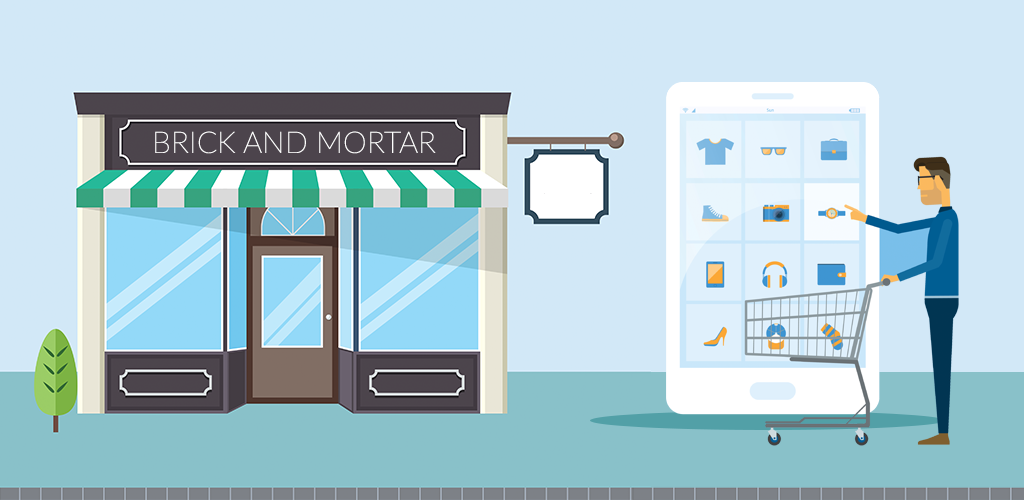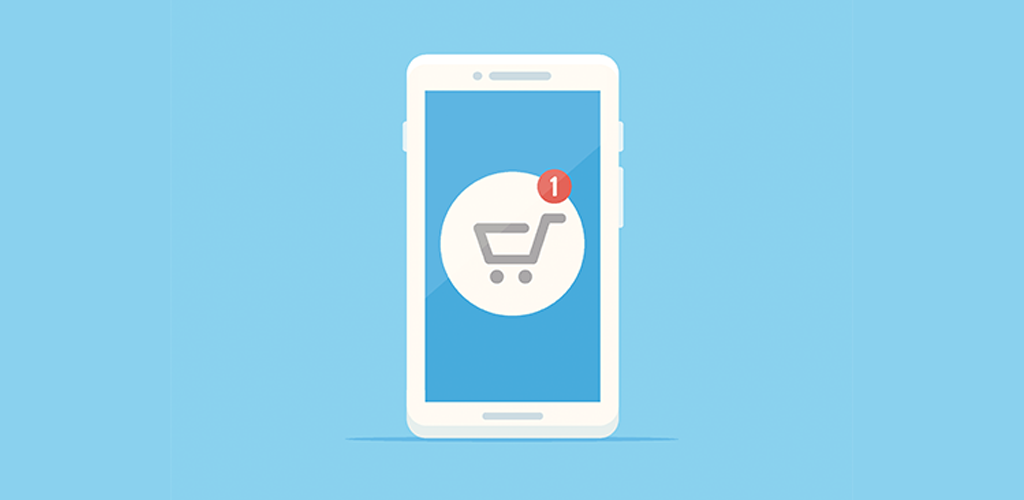eCommerce Vs. Brick and Mortar: The Differences, Pros, and Cons of Each

If you’re considering starting a business, you’ll have to decide if you want to launch an ecommerce site, physical store, or both. How do you know which is the best option for you? Both industries are absolutely massive, with the newer ecommerce option earning $453 billion in 2017. Physical retailers made $3043 billion in that same year. While in-person shopping still takes the lion’s share of income, online shopping is growing three times faster. But what makes ecommerce really different from physical merchants, and is it the right option for your business? Let’s take a look at the key differences between ecommerce and brick and mortar stores, and the pros and cons of running each:
- Location
- Transaction methods
- Customer connections
- Marketing
- Operating expenses
- Why do people prefer online shopping?
- Why do people prefer in-person shopping?
Location
The first and most important detail that differentiates the two types of businesses is where those businesses sell their products.
- eCommerce Businesses: eCommerce stores host their business online. Customers can shop the products from anywhere, but they cannot touch them or see more than a picture or video. Online stores have a huge advantage over physical retailers because they are able to sell to customers over a wider geographic area. Many sell to entire provinces/states, countries, and even to the whole world. Another pro enjoyed by online companies is that they are more convenient: for shoppers who don’t want the hassle and time requirement of in-person shopping, ecommerce is an excellent solution. Finally, ecommerce earnings are growing faster than brick and mortar sales and could one day exceed earnings from in-person shopping. The biggest con for online stores is that they incur costs that many physical retailers don’t. Online retailers must pay shipping costs (if they don’t ask customers to foot the bill), spend money on packaging items like boxes, and may also need to spend money on inventory storage because there are no digital shelves or storage rooms that can hold a physical product. Another disadvantage faced by online stores is the lack of interaction a customer can have with a product. The customer can’t feel, try on, or otherwise physically examine the product which might make them hesitant to buy.
- Brick and Mortar Stores: A brick store has a physical location to sell from, where customers can come and see the products in person. However, customers have to actually visit that location to shop with the business. The pros and cons associated with physical shops are essentially the opposite of those experienced by ecommerce stores. A physical store doesn’t have to worry about paying shipping costs (in most cases), they typically have storage rooms so extra inventory space often isn’t necessary, and their customers can take a close look at the products in person to help them decide whether or not to buy. One extra pro is that physical commerce provides instant gratification. Customers don’t have to wait days or weeks to receive their item. Instead, they walk out of the store with it. There are cons to selling in-person as well. Because in-person shoppers have to visit the store, well, in person, a physical retailer may notice limitations to the geographic regions they serve. A business that owns a single location might only be able to cater to a single town or city. However, businesses that run a larger chain can help compete against ecommerce in this respect. Consumers in a rush may also choose to buy online instead of in-store because it’s more convenient.
eCommerce Vs. Brick and Mortar: Making Transactions
A few decades ago, technology wasn’t advanced enough to easily make online payments, meaning goods had to be purchased in-person. However, modern tech has opened up payment options available to ecommerce stores that physical retailers can’t take advantage of. That being said, there are still some old classics of payment that physical stores can accept that online ones can’t.
- eCommerce Transactions: Online stores can accept several forms of payment, including credit cards, gift cards, PayPal, and sometimes debit cards or cryptocurrency. This means customers have a wide variety of choice when it comes to paying for their purchases. However, the one form of currency that online stores can’t accept is cash, which could turn away some potential customers. In addition, some consumers have concerns about the safety of online transactions and potential for data breaches that could lead to financial information being leaked to criminals.
- Physical Store Transactions: Physical stores allow customers to pay with debit, credit, gift cards, and cash. Many are also working on accepting other methods like Apple Pay. While many of these options are the same as what’s available on ecommerce platforms, the addition of cash payments make physical stores somewhat safer than online ones. The biggest con for physical stores is that they can’t accept PayPal. PayPal offers excellent protections for clients and businesses alike and many people prefer to pay using this method.
Customer Connections

Any successful business must build relationships with customers in order to generate revenue. The methods of doing this, however, differ between ecommerce stores and brick and mortar shops.
- eCommerce Connections: Without being about to see their clients in person, online stores have had to get creative to make those valuable connections. Popular methods include the use of social media, phone calls or texts, email, apps and live chats. Their ability to reach customers over a wide range of channels is excellent for cultivating loyal relationships and making new connections quickly. However, some consumers have a hard time connecting to brands they can’t put faces to.
- Physical Store Connections: Physical stores have a slight advantage when it comes to making customer connections. They can still utilize online methods such as social media and email, and they can also build face-to-face relationships with consumers. However, smaller businesses might struggle to set up online channels due to the time (and sometimes cost) they require.
Marketing
The way to market and promote an ecommerce store versus a brick and mortar one also differs somewhat (although they may employ similar tactics).
- eCommerce Marketing: Most online stores choose to advertise their business online as well. That’s where the customers are, and also the best way to reach a potentially global audience. Using social media to advertise is also a great way to increase customer engagement and it can often be cost effective depending on the channels you use. However, online advertising takes a lot of time and effort, constant monitoring, and can also be expensive, again depending on the channels you use.
- Physical Store Marketing: Physical stores can (and should) advertise online. However, many also choose to use traditional forms of advertising, including print and broadcast promotions. These methods are great at targeting specific audiences and regions. However, they are also often expensive and take a lot of time to do well.
Operating Expenses
Many entrepreneurs believe that an ecommerce business is cheaper to run, however they incur repeating costs just as a brick and mortar does. Those costs just take on a different form.
- eCommerce Operating Expenses: Some of the expenses an online store might have to deal with include website hosting fees, app costs, shipping costs, storage fees, marketing, and more. In addition, some (though certainly not all) ecommerce stores also need to pay rent for an office space.
- Physical Store Operating Expenses: Many physical retailers have to spend money on rent, storage, marketing, employees, and more.
Why Do People Prefer Online Shopping

The customers you are hoping to attract will be a big factor in choosing which business model to use for your venture. Here are some of the most common reasons consumers say they prefer shopping online:
- They can buy from an online store at any time of the day.
- It’s easier to price match online businesses and products.
- Online shopping is more convenient than fighting through traffic.
- It’s faster.
- There are no crowds or lines with online shopping.
- Many items are easier to find online.
- Free shipping makes online shopping more enticing.
Why Do People Prefer Brick and Mortar Stores?
Even though ecommerce is fast growing in popularity, many people still prefer to do their shopping in person. Here are a few reasons why:
- Being able to physically interact with the product makes it easier to buy.
- Consumers don’t have to wait for a product to be shipped to them if they buy it in person.
- They can talk to customer service reps in person rather than online.
- There are no shipping costs associated with buying in-person.
- Returning items is easier.
- The experience of shopping in person is more interactive.
Every year the revenue generated by retail grows bigger. Make sure you join that growth by choosing the best commerce option for your business.
Visit Shopivo and stay tuned for exciting news and updates! Sign up for our emails and stay up-to-date on new developments and features.
